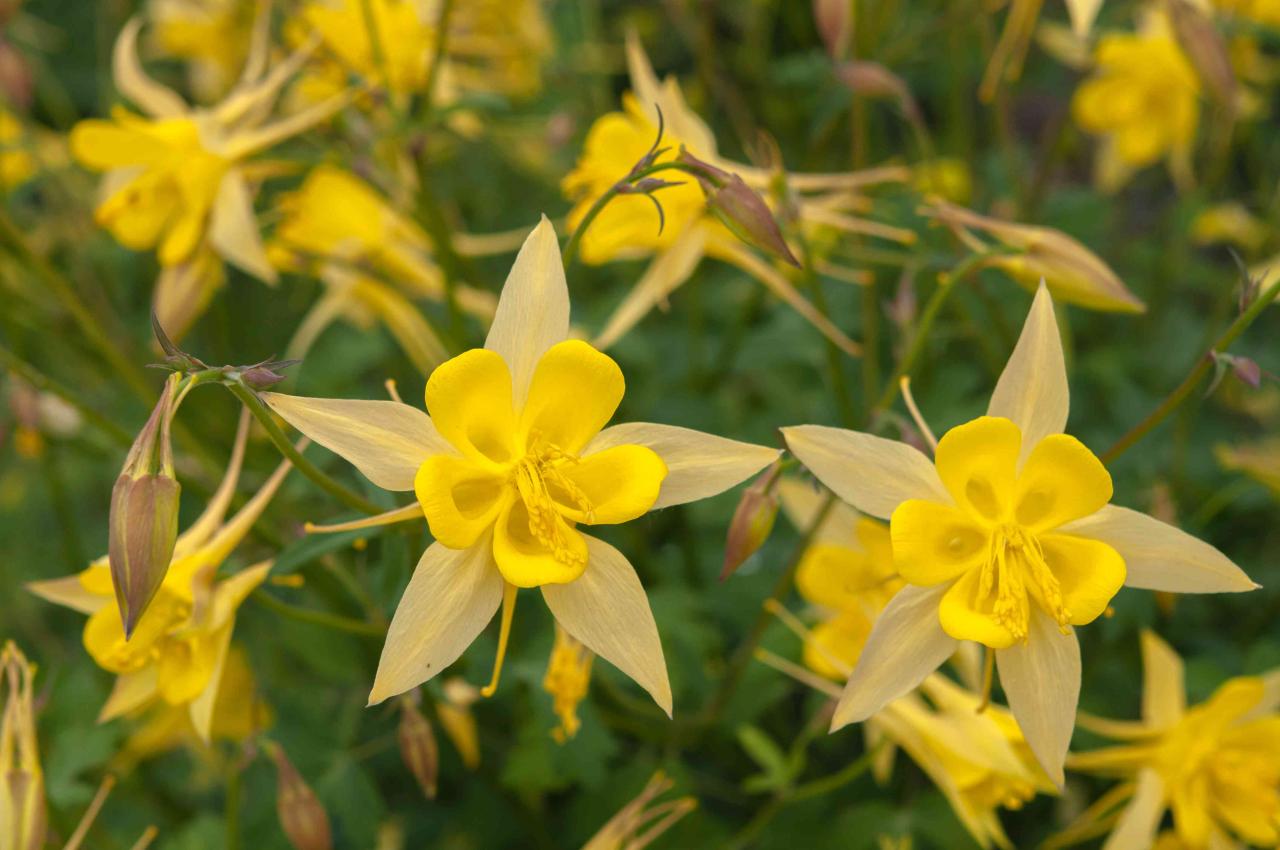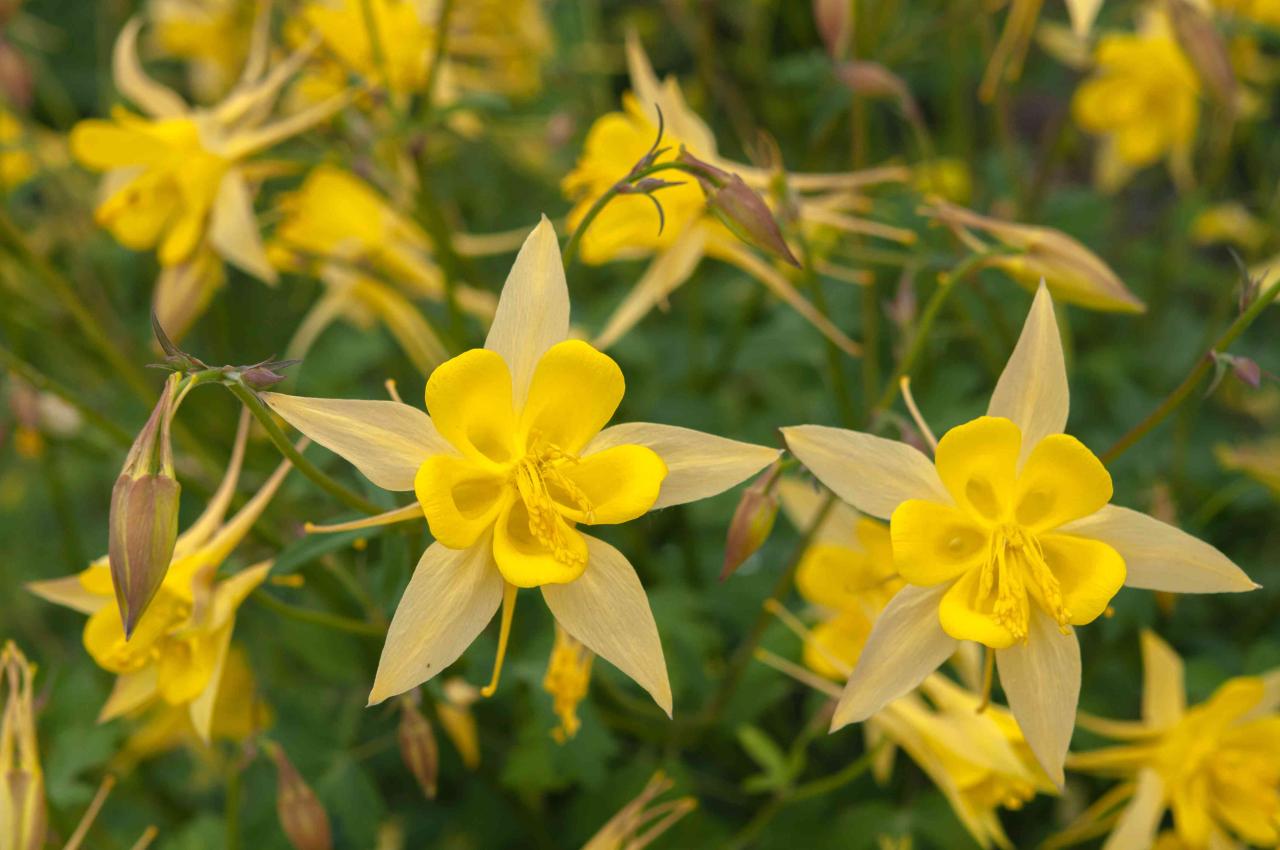How to Revitalize Your Columbine Plants Quickly and Easily: Columbine plants, with their delicate, bell-shaped flowers, are a cherished addition to any garden. However, these beauties can sometimes fall victim to environmental stressors, pests, or diseases, leading to a decline in their vibrant health.
This guide offers a comprehensive approach to revitalizing your Columbine plants, helping them regain their vitality and bloom in full glory.
By understanding the basic needs of Columbine plants and implementing simple yet effective techniques, you can transform your struggling plants into thriving specimens. We’ll cover everything from pruning and fertilizing to proper watering and mulching, providing you with the tools to ensure a healthy and vibrant display of these beloved flowers.
Understanding Columbine Plant Needs
Columbine plants are known for their delicate beauty and vibrant colors, but their health depends on meeting their specific growing requirements. Providing the right conditions will ensure your Columbines thrive and reward you with an abundance of blooms.
Sunlight Requirements
Columbine plants prefer partial shade to full shade, especially in warmer climates. Direct sunlight can scorch their leaves and reduce flower production. Ideal conditions include morning sun and afternoon shade or dappled sunlight throughout the day.
Soil Requirements
Columbine plants thrive in well-drained, fertile soil with a slightly acidic pH (6.0-6.5). They prefer soil that is rich in organic matter, such as compost or leaf mold. Avoid planting Columbines in heavy clay soil that can retain too much moisture and lead to root rot.
Water Requirements
Columbine plants need consistent moisture, especially during the growing season. However, they are also susceptible to overwatering, which can lead to root rot. The best practice is to water deeply but infrequently, allowing the top inch of soil to dry out between waterings.
Common Issues Affecting Columbine Health
Columbine plants can be susceptible to various pests, diseases, and environmental stressors that can impact their health.
Pests
- Aphids:These small, sap-sucking insects can cause leaves to curl and distort, and can transmit diseases.
- Spider mites:These tiny pests can cause leaves to turn yellow and drop, and can spin fine webs on the underside of leaves.
- Slugs and snails:These pests can damage leaves and flowers, leaving behind slimy trails.
Diseases
- Powdery mildew:This fungal disease causes a white, powdery coating on leaves, which can eventually lead to leaf drop.
- Leaf spot:This fungal disease causes brown or black spots on leaves, which can weaken the plant and reduce its vigor.
- Root rot:This fungal disease occurs when soil is too wet and can cause wilting, yellowing, and eventual death of the plant.
Environmental Stressors
- Drought:Prolonged periods of dry weather can stress Columbine plants, leading to wilting and reduced flowering.
- Heat:Extremely hot temperatures can scorch leaves and reduce flower production.
- Poor drainage:Soil that doesn’t drain well can lead to root rot and other problems.
Revitalizing Techniques

Revitalizing your Columbine plants involves a few simple yet effective techniques. By following these steps, you can help your plants thrive and produce beautiful blooms year after year.
Pruning Dead or Damaged Foliage
Regularly removing dead or damaged foliage is essential for encouraging new growth. This practice allows the plant to focus its energy on healthy areas, promoting vigorous growth and flower production.
- Use sharp, clean pruning shears to cut back any withered, yellowed, or diseased leaves.
- Remove any spent flower stalks to encourage the plant to produce more blooms.
- Pruning should be done throughout the growing season, as needed.
Fertilizing Columbine Plants
Columbine plants benefit from regular fertilization, especially during the growing season. This provides them with the necessary nutrients to flourish.
Revitalizing your columbine plants is a breeze with a few simple steps. First, ensure proper drainage and amend the soil with compost. For a similar approach to revitalizing your garden, check out The Best Tips for Growing Rodgers Plants Successfully , which offers helpful advice on fostering robust growth.
Remember, consistent watering and regular deadheading will help your columbine plants thrive and bring vibrant color to your garden.
- Use a balanced, water-soluble fertilizer, diluted according to package instructions.
- Apply fertilizer around the base of the plant, avoiding direct contact with the stems and leaves.
- Fertilize every 4-6 weeks during the growing season, or as needed.
Watering Techniques, How to Revitalize Your Columbine Plants Quickly and Easily
Columbine plants prefer consistently moist soil but are susceptible to overwatering. Therefore, it’s crucial to water them deeply but infrequently.
- Water thoroughly, ensuring the soil is moist to a depth of several inches.
- Allow the top inch of soil to dry out between waterings.
- Avoid overwatering, as this can lead to root rot.
Mulching Around Columbine Plants
Mulching around Columbine plants offers several benefits, including moisture retention, weed suppression, and temperature regulation.
Knowing how to revitalize your columbine plants quickly and easily is essential for ensuring their continued beauty and health. One key factor in creating a vibrant display is understanding the principles of garden design. For inspiration, consider reading our article on How to Design a Stunning Columbine Plant Garden Display , which will help you create a stunning and harmonious arrangement.
By applying these principles, you’ll not only enhance your existing columbine plants but also cultivate a thriving garden that’s sure to impress.
- Apply a layer of organic mulch, such as shredded bark, wood chips, or compost, around the base of the plants.
- Maintain a mulch layer of 2-3 inches deep.
- Mulch helps to retain moisture, reducing the need for frequent watering.
- It also suppresses weed growth, reducing competition for nutrients and water.
Preventing Future Decline
Revitalizing your Columbine plants is a great first step, but to ensure they thrive long-term, it’s crucial to implement a preventative maintenance plan. This involves understanding the plant’s needs, addressing potential issues proactively, and creating a schedule for regular care.
Regular Maintenance Schedule
Establishing a routine for caring for your Columbine plants can make a significant difference in their health and longevity. Here’s a suggested schedule for regular maintenance tasks:
- Pruning:Prune faded flowers regularly to encourage new blooms and prevent the plant from expending energy on seed production. This can be done throughout the growing season, typically every few weeks.
- Fertilizing:Columbine plants benefit from regular fertilization, particularly during the growing season. Use a balanced fertilizer, such as a 10-10-10 formula, diluted to half strength. Apply fertilizer every 4-6 weeks.
- Watering:Columbine plants prefer moist soil, but they don’t tolerate waterlogged conditions. Water deeply and infrequently, allowing the top inch of soil to dry out between waterings.
Common Pests and Diseases
Columbine plants are generally resilient, but they can be susceptible to certain pests and diseases. Early detection and preventative measures are key to protecting your plants.
- Aphids:These tiny insects feed on plant sap, causing leaf distortion and stunted growth. Control them with insecticidal soap or a strong blast of water from a hose.
- Spider Mites:These microscopic pests also feed on plant sap, causing yellowing and stippling of leaves. Treat them with a miticide or a mixture of water and dish soap.
- Powdery Mildew:This fungal disease appears as a white, powdery coating on leaves. Improve air circulation and avoid overhead watering to prevent its spread.
- Leaf Spot:This fungal disease causes brown or black spots on leaves. Remove infected leaves and improve air circulation to prevent its spread.
Choosing the Right Location
The location you choose for your Columbine plants can significantly impact their health and growth. Consider the following factors when selecting a spot for them:
- Sunlight:Columbine plants prefer partial shade to full sun. They thrive in locations that receive 4-6 hours of sunlight per day.
- Soil:Columbine plants prefer well-drained soil that is rich in organic matter. They tolerate slightly acidic to slightly alkaline soil pH.
Visual Aid
A visual comparison can help you quickly identify the signs of stress in your columbine plants. By observing the key differences between a healthy and a stressed columbine, you can take timely action to revitalize your plants and ensure their long-term health.
Columbine Plant Health Comparison
Healthy Columbine |
Stressed Columbine |
|---|---|
Final Conclusion: How To Revitalize Your Columbine Plants Quickly And Easily
With a little TLC and a few simple steps, you can revitalize your Columbine plants and enjoy their beauty for years to come. By addressing the root causes of their decline, providing the right care, and implementing preventative measures, you’ll ensure that your Columbine plants flourish, adding a touch of elegance and color to your garden.
Frequently Asked Questions
How often should I prune my Columbine plants?
Prune your Columbine plants in the spring, removing any dead or damaged foliage to encourage new growth. You can also prune lightly throughout the growing season to maintain their shape and encourage bushier growth.
What type of fertilizer is best for Columbine plants?
Use a balanced fertilizer with a ratio of 10-10-10 or 14-14-14. Apply it in the spring, following the instructions on the fertilizer label.
Can I propagate Columbine plants from seed?
Yes, Columbine plants can be propagated from seed. Sow the seeds in the fall or early spring, and they should germinate within a few weeks.
What are some common pests that affect Columbine plants?
Common pests include aphids, spider mites, and slugs. You can control these pests with insecticidal soap or by handpicking them off the plants.
How can I prevent diseases from affecting my Columbine plants?
Provide good air circulation around your plants, avoid overwatering, and choose disease-resistant varieties to minimize the risk of disease.
